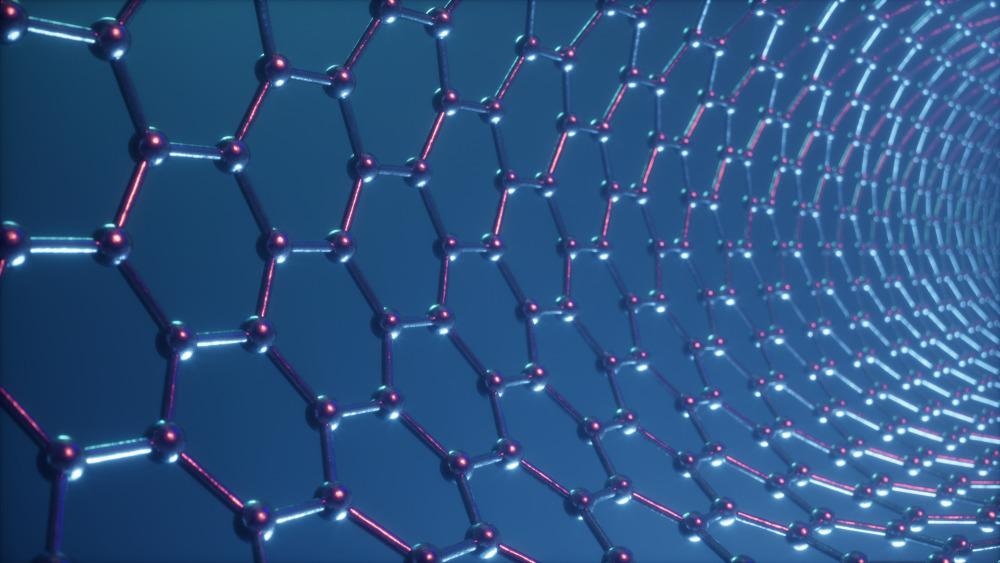In a recent study published in the open-access journal Science Reports, researchers analyzed the effect of twist angle on optical and electrical properties of twisted bilayer graphene (tBLG). They fabricated in situ tBLG with twist angles that can be continuously tuned over a wide range with high precision. This finding opens a new path for the applicability of twistronic devices.

Study: In-situ twistable bilayer graphene. Image Credit: Rost9/Shutterstock.com
Background
Two-dimensional (2D) materials such as monolayer graphene, hexagonal boron nitride (hBN), and transition metal dichalcogenides have garnered a lot of attention in electronic devices due to their Fermi level interaction. However, in recent times, bilayer 2D materials have shown some extraordinary phenomena that make them suitable for specific electronic applications.
Bilayer graphene (BLG) has zero bandgaps between both graphene layers. However, this can be tunable by various methods such as doping, hydrogenation, fluorination, alloying with hBN, and applying a high external electric field vertically to graphene sheets. The electrical and optical properties of AA stacked BLG (i.e., each carbon atom of the top layer is vertically above the carbon atom of the bottom layer) are rather inferior to that of monolayer graphene.
Meanwhile, twisted BLG has shown significant enhancement of these properties. Especially, magic-angle (~1.1⁰) twisted BLG exhibits superconductivity, interaction-induced insulating states, ferromagnetism, electronic nematicity, quantized anomalous Hall states, and linear low-temperature resistivity. At this magic angle, the hybridization between two electronic bands produces a moiré superstructure with a flat low-energy band.
The twist angles obtained using the most commonly used “tear-and-stack” technique are not tunable. Thus, to analyze the effect of twist angle on the properties of tBLG, the most commonly used approaches are either fabricating multiple samples with different twist angles or using an uncontrolled thermal rotation method.
About the Study
In this study, researchers analyzed the effect of twist angle on the properties of tBLG in a single sample with in situ tunable twist angle without incorporating the thermal rotation method. The setup consisted of large-size bottom-layer graphene, a relatively small-size top-layer graphene, and a hollow hBN gear in between. The two graphene layers met with each other at the central hollow region of the hBN gear. Atomic force microscopy (AFM) tip was used to continuously rotate the hBN gear and the top graphene layer simultaneously to achieve desired twist angle.
The hBN gear and top graphene layer were mechanically exfoliated on the silica substrate layer-by-layer using dry transfer methods. A hydrogen plasma of 30 W power was used to remove adhesive residue from each layer. Finally, the twist angle was confirmed by AFM and scanning near-field optical microscopy (SNOM).
Observations
The friction between the bottom graphene layer and the hBN gear was significantly low due to Vander Waal’s interaction, which assisted the AFM tip to rotate the hBN gear with ease. The maximum moiré superlattice period of the graphene/hBN heterostructure was about 15 nm. The hBN gear was rigid with a thickness of ~140 nm, whereas the graphene layers had a thickness of 0.34 nm.
After the twisting with AFM tip, the twist angles of the three states were 3°, 14°, 16°, respectively. Also, there was a perfect match between the twisting angle of the top-layer graphene and the twisting angle of the hBN gear. Moreover, Raman spectra were visible at a few representative twist angles viz. 1°, 3°, 6°, 10°, and 16°. The intensity of the G peak of tBLG was significantly increased when the twist angle was around 10° owing to resonance between excitation energy and the energy of van Hove singularities.
Furthermore, the moire superlattice period of tBLG was precisely revealed using a combination of AFM and SNOM characterization. The shortest and longest moiré superlattice periods were 195 nm and 250 nm with the corresponding twist angles of 0.07° and 0.05°, respectively. The extracted inhomogeneity value was 0.02°.
Conclusions
To conclude, the researchers of this study replicated a single tBLG sample with a twist angle that can be precisely tuned over a wide range (i.e. 0-30°) without incorporating the thermal rotation method. An hBN gear was sandwiched between two layers of graphene, which could be rotated using an AFM tip.
The experimental setup can be used for any other bilayer 2D materials such as transition metal dichalcogenide, α-MoO3, and black phosphorus. Hence, this method opens up a new pathway to study twistronic devices.
Disclaimer: The views expressed here are those of the author expressed in their private capacity and do not necessarily represent the views of AZoM.com Limited T/A AZoNetwork the owner and operator of this website. This disclaimer forms part of the Terms and conditions of use of this website.
Sources:
Hu, C., Wu, T., Huang, X. et al. In-situ twistable bilayer graphene. Sci Rep 12, 204 (2022).
https://www.nature.com/articles/s41598-021-04030-z